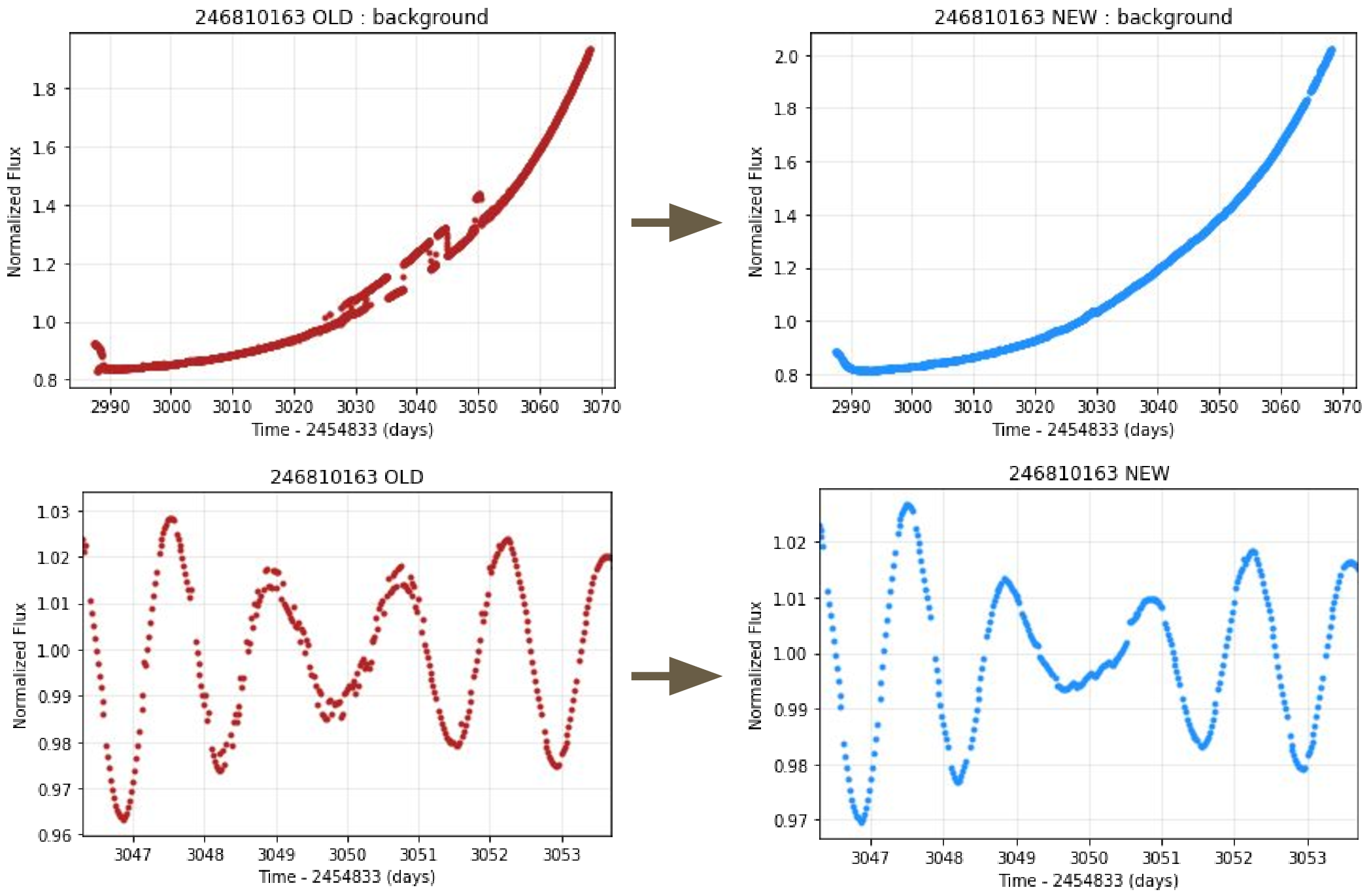A few months ago we announced that we were undertaking an effort to reprocess campaigns 0–14 using the same version of the Kepler/K2 pipeline used for C15 and subsequent campaigns. This version introduced several new features and improvements, such as more sophisticated pixel calibration, better identification of spacecraft pointing, improved cosmic ray correction, and production of short-cadence lightcurves, along with several other minor improvements. Please see the associated news post for details on each feature.
Reprocessed data and release notes from campaigns 2, 3, and 13 have been made available over the past few months. The newest data are available via the usual K2 data download interfaces at the MAST archive; the older data has been kept available via the MAST browser interface (e.g., here for tarballs of the old target pixel files (TPFs) and here for tarballs of the old lightcurve files, if previously produced). The data release notes have been updated for each reprocessed campaign, available at the nominal K2 Data Release Notes page; links to the old version of the release notes are also provided for posterity.
In the two figures below, we show the current status of major and minor new features and improvements as a result of the reprocessing effort. Below those, we highlight a few examples of these improvements and new features from C2, C3, and C13 that are likely to be of interest to users.
The next reprocessed campaign to be delivered will be C0, currently expected in November, followed by C11 and then C1 — see this post for the expected processing order of additional campaigns. (Note that the reprocessing activity does not impact the regular deliveries of newly obtained data, e.g., C18, currently expected in early November.)
Questions/Comments? Please e-mail Jeff Coughlin.


Notable changes to the data from campaigns 2, 3, and 13:
-
In the original C2 processing, lightcurves were not produced, and TPFs were "Type-1", which had poor WCS information and other limitations compared to the "Type-2" TPFs that were produced in later campaigns. (For details on the difference between Type-1 and Type-2 TPFs, see section 2.4 of the K2 Handbook.) As a result of reprocessing, Type-2 TPFs, lightcurves (both long- and short-cadence), and cotrending basis vectors (CBVs) are now available for C2.
-
One of the major improvements from the global reprocessing is the use of an algorithm called "Dynablack", which is essentially a more sophisticated way to perform the CCD pixel-level calibration that accounts for time-varying, instrument-induced artifacts in the pixel data. One benefit of Dynablack is that it is able to correct crosstalk from the fine guidance sensors, resulting in improved background correction for certain channels. As shown below, for channel 41 in the original C2 processing, the old CCD calibration method resulted in varying background level as a function of position on the CCD. In the reprocessing, the use of Dynablack resulted in a significantly better correction and more uniform background levels.
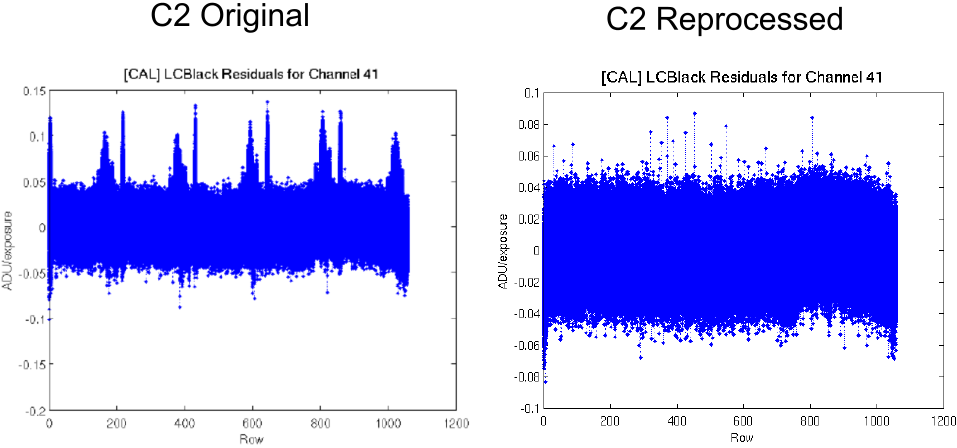
- As part of the reprocessing, we are now producing short-cadence lightcurves for all objects that were observed in short-cadence mode. We note that the detrending method used to produce the short-cadence PDC lightcurves, which was developed to work on Kepler data, is not optimal for K2 data, and thus they are expected to be of varying quality. However, we are producing them with the expectation that at least some objects will be of high quality, and/or their existence will spurn more detailed investigation. Below we show the short-cadence PDC lightcurve for EPIC 206003187, an RR Lyrae-type variable observed in C3. While there are still residual systematics near thruster-firing events, simply removing those points near thruster firing events results in a well-detrended phased lightcurve with a clearly visible Blazhko effect.

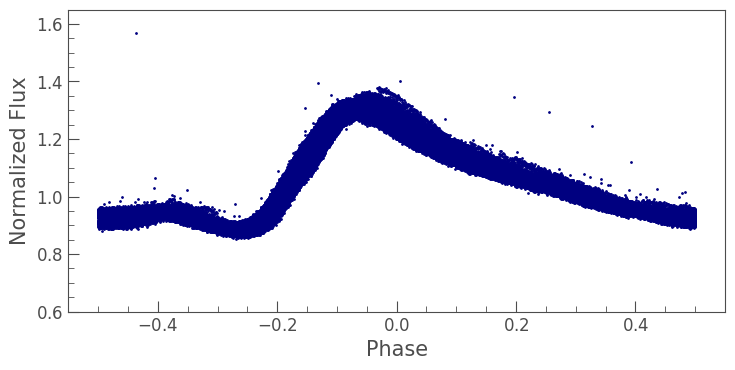
- While examining the results of the C3 reprocessing we found that several thousand targets had significantly different optimal photometric apertures compared to the original processing. There appears to have been either a bug or configuration error in the original C3 processing that affected these targets; the reprocessed apertures appear correct, and upon subsequent examination we do not find this bug to have affected any other campaign. We show an example below for EPIC 206393582 where the pixels comprising the optimal aperture are identified via a transparent purple overlay. In the original processing, the optimal aperture was a single pixel to the right of the target, which is clearly wrong — in the reprocessing the optimal aperture is 4 pixels centered on the target. This was an unanticipated benefit of performing the global uniform reprocessing.
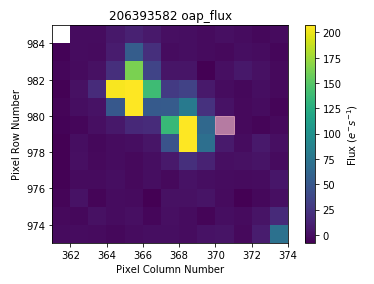
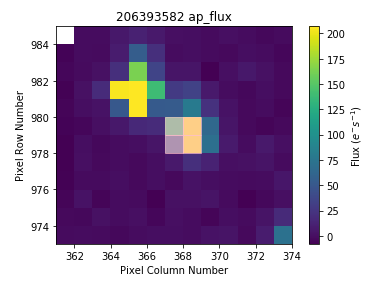
- In the original processing of C13, the presence of the first magnitude star Aldebaran on channel 73 led to a time-varying error in the smear correction for channel 74, which shares the same physical CCD (see the Kepler CCD layout). As a result, every target on channel 74 had time-varying background levels, and the resulting lightcurves showed a "chattering" effect of significant point-to-point changes in flux (see the old C13 data release notes for details). Below we show an example target from channel 74, EPIC 246810163, a hot star with apparent astrophysical variability. As can be seen on the left, the "chattering" effect is visible in both the background flux and resulting lightcurve for this target. When reprocessing, an update to the smear correction routine was able to significantly better account for the flux bleed from Aldebaran — this resulted in a nominal, smoothly time-varying background flux and thus significantly better lightcurve.
